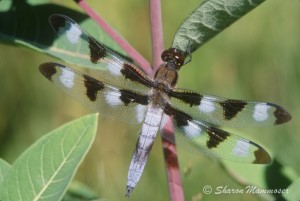 This week’s Creature Feature is the group of animals we call DRAGONFLIES. In the world there are more than 6500 species of dragonflies with a little over 400 in North America. Dragonflies are found almost anywhere that there is freshwater, on every continent except Antarctica.
This week’s Creature Feature is the group of animals we call DRAGONFLIES. In the world there are more than 6500 species of dragonflies with a little over 400 in North America. Dragonflies are found almost anywhere that there is freshwater, on every continent except Antarctica.
Check out the slideshow at the end of the post!
As a photographer, I love to look for and take pictures of dragonflies. It is can be difficult to get close enough to get a full-frame shot but I enjoy the challenge and have discovered that sometimes, if I follow them around enough, their tolerance of me will grow, allowing me to get close enough for a good shot. Also I enjoy looking for them on dewy mornings in August when their wings are covered with hundreds of tiny droplets of water and they are essentially “frozen” until the sun comes out and warms them. Finding them in this state is always a thrill because I know I can get as close as I need and they aren’t going anywhere.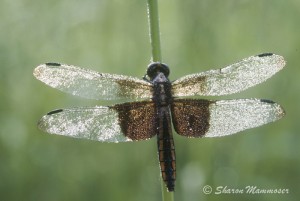
Here are some interesting things about dragonflies:
1. Dragonflies are insects (insects have three body parts, a hard exoskeleton, three pairs of legs, a pair of antennae) that have been around since BEFORE the dinosaurs, some 300 million years! Fossils of dragonflies have been discovered that have a wingspan of 28.5 inches! This is amazing! The largest dragonfly we find today has a wingspan of 6 inches.
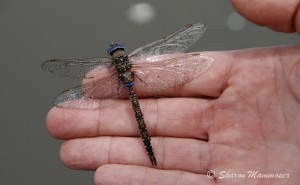 2. Contrary to popular belief, dragonflies do not sting and will not bite unless handled roughly. It is not unusual for one to land on someone in a canoe or kayak, perching a moment like a winged jewel. When this happens to me I always think of it as good luck, feeling happy that they trusted me enough to stop momentarily. They do not have a stinger like bees and wasps. Many cultures use the dragonfly as a symbol of adaptability in life and as new light and joy.
2. Contrary to popular belief, dragonflies do not sting and will not bite unless handled roughly. It is not unusual for one to land on someone in a canoe or kayak, perching a moment like a winged jewel. When this happens to me I always think of it as good luck, feeling happy that they trusted me enough to stop momentarily. They do not have a stinger like bees and wasps. Many cultures use the dragonfly as a symbol of adaptability in life and as new light and joy.
3. Dragonflies are fierce predators their entire life. After hatching from eggs laid in bodies of freshwater, young dragonflies, called nymphs or naiads, eat other aquatic invertebrates. As nymphs, they have an extendable lower lip called a labium that they use to catch prey, using it like a spear that shoots out at rocket speed to grab an unsuspecting insect or tadpole. Larger nymphs can even feed on small fish! As adults with wings, dragonflies eat a variety of insects from bees to butterflies to mosquitoes and flies. Many snag prey in mid-air, then land to feast on their prize.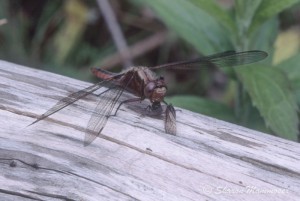
4. Dragonflies, like butterflies, can be many different colors, including all the usual ones, like red, blue, green, gold, purple, brown, white and black. Their 4 net-like wings cannot be folded like most insects’ wings and are not fused together so can operate independently. This makes them excellent fliers, capable of going forward, backwards, and hovering in place. Some of the larger species can reach speeds of more than 20 miles per hour! See slideshow below!
5. Dragonflies regulate their body temperature by changing the position of their body with regards to the sun. When it is hot outside and they want to cool off, they will rest with the tip of their abdomen towards the sun. When it is cool and they need to warm up, they will hold their wings flat in the sun, like giant solar panels.
6. Dragonflies start their lives in a body of freshwater, as eggs, that hatch into nymphs. The nymphs have gills and live in the water for a period of time depending on the species. They will go through a series of molts, up to 17, before their transformation to adults. In the United States, most dragonflies take about 11 months to reach adulthood. In the tropics, some species of dragonflies may live underwater as nymphs for 5-7 years.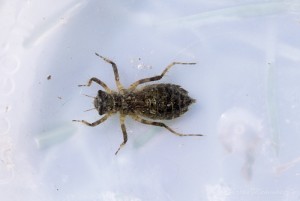
7. When a dragonfly first transforms from a nymph into an adult, they are pale yellow or greenish and are called teneral adults. In this stage they will spend time away from the pond or stream which could be a few days to a few weeks depending on the species. When a nymph is transforming into an adult they are super vulnerable. If the weather turns bad, if they fall to the ground, if another nymph crawls over them or something touches them as they are emerging from their nymphal skin, they can be deformed or die. As nymphs waiting for their wings to dry they are defenseless against birds or other predators that discover them helpless.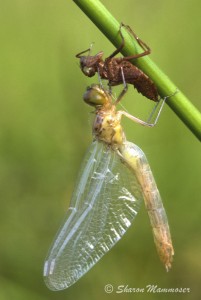
8. Most people think the Monarch Butterfly has the longest migration of any insect but a biologist named Charles Anderson has proved them wrong. A dragonfly named the Globe Skimmer migrates 11,000 miles round trip, traveling from India to the Maldives and then on to Africa and back again in a single year. This is the longest migration of any insect! To avoid strong winds that might push them off course, they reach heights of 3,000 feet. To read more about this amazing discovery, CLICK HERE.
9. Nymphs have a variety of ways for avoiding being eaten by predators. Besides their excellent camouflage, some species will play dead, allowing their limp bodies to float downstream. Others shoot water out of their butts, propelling themselves forward and away from predators like salamanders. As a last resort, they might shed a leg in an attempt to escape. They will grow this back at their next molt.
10. When dragonflies mate, they form what is known as a wheel and some species even fly around in this position. The female curls her abdomen around to access the sperm from the male. Some males are super protective, flying with the female as she dips her abdomen in the water to lay her eggs–which are microscopic and about the size of the period at the end of this sentence!– to make sure she doesn’t mate with another male. 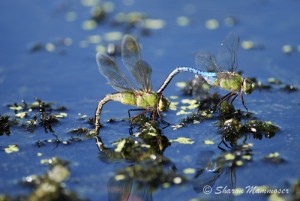
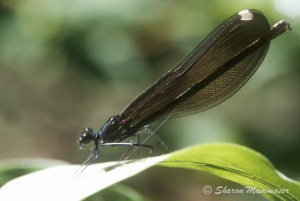
Last but not least, there is a related insect called a damselfly. You have likely seen these flying around the pond along with dragonflies. Damselflies are usually smaller and dainter looking and they usually hold their wings over their bodies instead of open on the sides. If you’d like to learn more about DAMSELFLIES, check out this post!
A note about the slideshow pictures: I am not an entomologist. When identifying insects based on a photo in a book or on a website, I do my best to id them but sometimes am not 100% sure.
References:
Dragonflies through Binoculars by Sidney W. Dunkle published by Oxford University Press in 2000
Wild Guide to Dragonflies by Cynthia Berger published by Stackpole Books in 2004

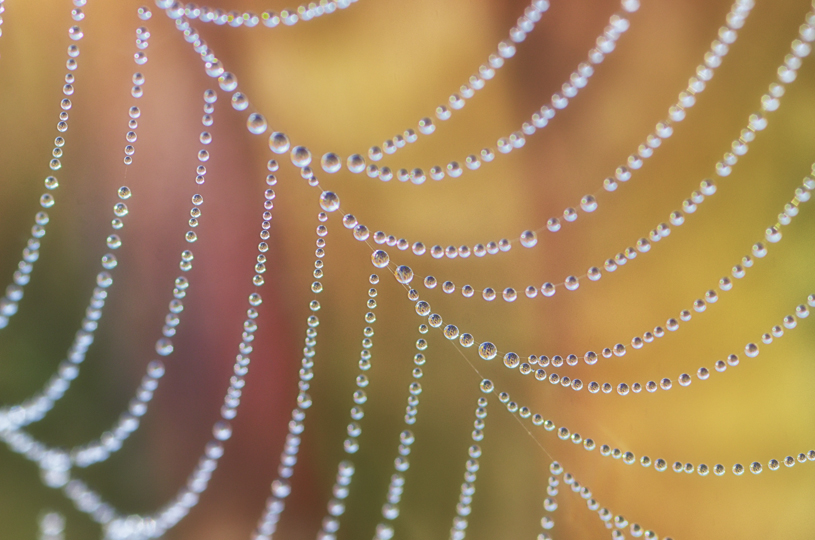

2 thoughts on “Do Dragonflies Sting or Bite? 10 Things You Didn’t Know”
Comments are closed.